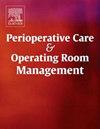Comparison of post operative analgesia following intraperitoneal instillation of ropivacaine with or without dexamethasone for patients undergoing laparoscopic surgeries
IF 1
Q2 Nursing
Perioperative Care and Operating Room Management
Pub Date : 2025-01-30
DOI:10.1016/j.pcorm.2025.100475
引用次数: 0
Abstract
Aim
To analyse how combining ropivacaine with dexamethasone in multimodal analgesia amplifies pain management and decreases postoperative discomfort (including nausea, vomiting, and rescue analgesia use) compared to using ropivacaine alone in patients undergoing laparoscopic surgery, with a focus on improving recovery outcomes.
Results
The initial patient distribution between groups showed no significant difference, our study highlighted substantial differences in key outcomes. Patients receiving multimodal analgesia (ropivacaine with dexamethasone) had significantly less postoperative nausea, vomiting, lower pain scores (VAS), decreased need for rescue analgesia, and longer intervals before requiring additional pain relief compared to those receiving ropivacaine alone.
Conclusion
Combining ropivacaine with dexamethasone for laparoscopic surgery patients gives superior pain relief compared to using ropivacaine alone. This dual approach not only reduces pain more effectively but also reduces nausea, vomiting, and the use of additional pain medication. It aims to enhance postoperative comfort and expedite recovery for patients undergoing these procedures."
腹腔注射罗哌卡因加地塞米松或不加地塞米松对腹腔镜手术患者术后镇痛的比较
目的分析与单独使用罗哌卡因相比,罗哌卡因联合地塞米松用于腹腔镜手术患者的多模式镇痛如何增强疼痛管理,减少术后不适(包括恶心、呕吐和抢救性镇痛),并重点关注改善恢复结果。结果两组患者的初始分布无显著差异,我们的研究突出了关键结局的实质性差异。与单独接受罗哌卡因的患者相比,接受多模式镇痛(罗哌卡因与地塞米松联合)的患者术后恶心、呕吐明显减少,疼痛评分(VAS)较低,救助性镇痛需求减少,需要额外疼痛缓解的间隔时间较长。结论罗哌卡因与地塞米松联用对腹腔镜手术患者疼痛的缓解效果优于单独使用罗哌卡因。这种双重方法不仅能更有效地减轻疼痛,还能减少恶心、呕吐和额外止痛药的使用。它的目的是提高术后舒适度,加快患者的康复。”
本文章由计算机程序翻译,如有差异,请以英文原文为准。
求助全文
约1分钟内获得全文
求助全文
来源期刊

Perioperative Care and Operating Room Management
Nursing-Medical and Surgical Nursing
CiteScore
1.30
自引率
0.00%
发文量
52
审稿时长
56 days
期刊介绍:
The objective of this new online journal is to serve as a multidisciplinary, peer-reviewed source of information related to the administrative, economic, operational, safety, and quality aspects of the ambulatory and in-patient operating room and interventional procedural processes. The journal will provide high-quality information and research findings on operational and system-based approaches to ensure safe, coordinated, and high-value periprocedural care. With the current focus on value in health care it is essential that there is a venue for researchers to publish articles on quality improvement process initiatives, process flow modeling, information management, efficient design, cost improvement, use of novel technologies, and management.
 求助内容:
求助内容: 应助结果提醒方式:
应助结果提醒方式:


